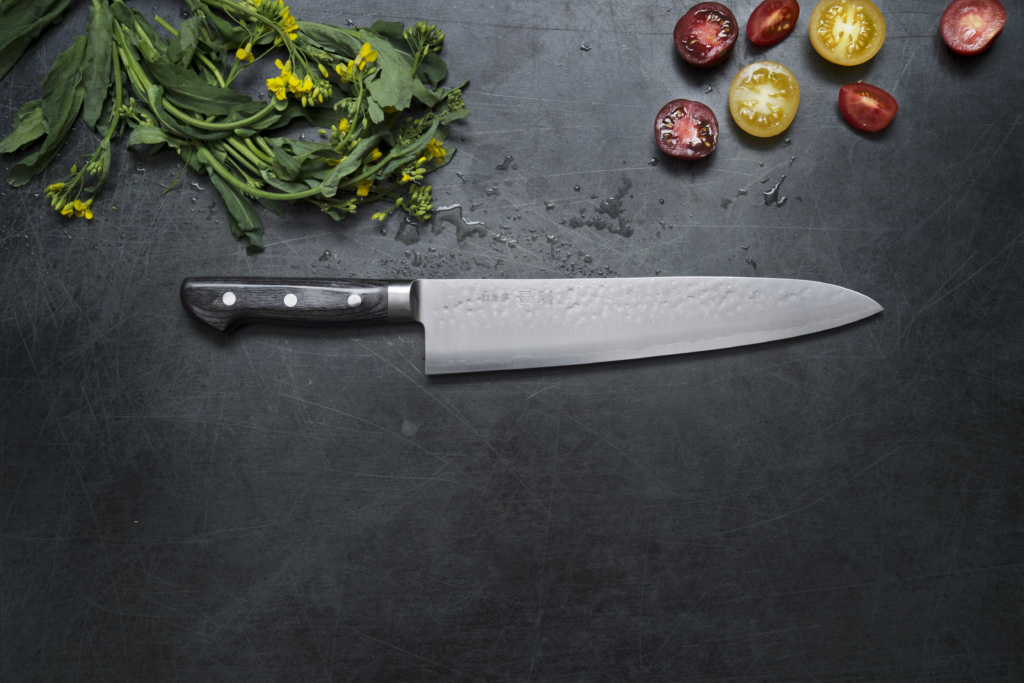Choosing a chef’s knife might seem overwhelming with all the options available, so we put together this handy guide to walk you through all the decisions required to help you choose the perfect knife for you.

Blade Angle
There is a lot of confusion about Japanese knives being either “right-handed or left-handed” based on the angle at which the blade is sharpened. While this is true for traditional single-edged Japanese knives in styles like deba, yanagi, and usuba, where the blacksmith produces right-handed knives (meaning the cutting edge is 100% on the side that works when used in your right hand), left-handed versions are available by special order. [We stock a few left-handed styles of deba in our Kitaoka collection. ]
When talking about chefs knives, or gyutou as they are called in Japanese, there is always some angle on both sides, generally 50/50 or 70/30. The 50/50 is equally balanced and therefore great for both right- and left-handed use. You can find the bevel balance included in the specifications listed for each knife. You can also use our filter system on the left-hand side to include or exclude certain blade angles.
Knife Length
Chef’s knives or gyutous’ blades are usually between seven and nine inches long. The length that is right for you will be determined by two factors. First, how big your hand is, and second, what you are cutting most. The knife should be comfortable and easily controlled and more or less be able to cut your ingredient in one stroke. If you have small hands and mostly cut onions and carrots, a seven-inch gyutou might be right for you. The eight-inch is most popular and suitable for a wide range of users and ingredients. More experienced cooks might find that a choosing a chef’s knife with a nine-inch blade allows for quick work when dealing with large ingredients.
Weight
Overall, most people find Japanese knives considerably lighter than the German- or French-made knives they have used before. This will come down to personal preference, but some blades are exceptionally thin and light, such as our Takamura, Takeda, and Shibata lines.
The majority of knives will fall into medium weight, like those in the Sakai Takayuki and Chubo Inox lines. Lastly, some people are drawn to heftier knives where the natural weight of the knife can assist in cutting denser ingredients. For those situations, we recommend knives from Kazan and Glestain.
Steel Types
There are pros and cons to every type of steel, but the first consideration is choosing between a stain-resistant or a high carbon steel option. Carbon steel knives are popular with professional chefs, thanks to their ability to get super sharp and hold an edge through heavy use, but they need to be kept very clean and dry, especially when cutting acidic ingredients. Among the options for stainless blades, most every Japanese option will stay sharp longer than average. The options then come down to balancing different pros and cons like blade strength versus brittleness of sharpening.
Hardness
Generally speaking, a harder steel will hold an edge longer but can be more challenging to sharpen. Hardness (HRC) is judged on the Rockwell scale, with a higher rating corresponding to greater hardness. You can find the rating for each product under specifications, with most of our knives falling in the 59-66 range. We recommend people new to Japanese knives and sharpening to start with knives on the lower end of that range.
Handle Type
You may notice two major options for handles on Japanese knives. First, the Western style is attached to the blade with rivets like you would expect with any high-quality knife. Second is a wood handle, either round, D-shaped, or octagonal and attached with a ferrule usually crafted from horn. This is mostly a matter of personal preference, but many find the natural wood of the handle comfortable, stable to grip, and versatile for various tasks and angles.
Price
Lastly, price is usually a key factor in choosing a chef’s knife. We have a wide range of chef’s knives for all budgets. At the introductory level, lines like Chubo Inox or Tojiro are a great value for a knife that is made with a lot of attention to detail and care. High-technology steels and more valuable handle materials lead to higher prices like you’ll find in our Takamura and Makoto Kurosaki lines. Lastly, hand-forged knives from master blacksmiths and those created entirely by hand will be priced according to the materials, skill, and amount of time that it takes to produce. Knives from makers like Takeda, Saji Takeshi, and Kagekiyo are made in small quantities by true master craftsmen and are meant to last a lifetime, and the prices reflect that.
We hope this guide helps you narrow down your options when choosing a chef’s knife. As always, we are here to answer any questions you may have.

